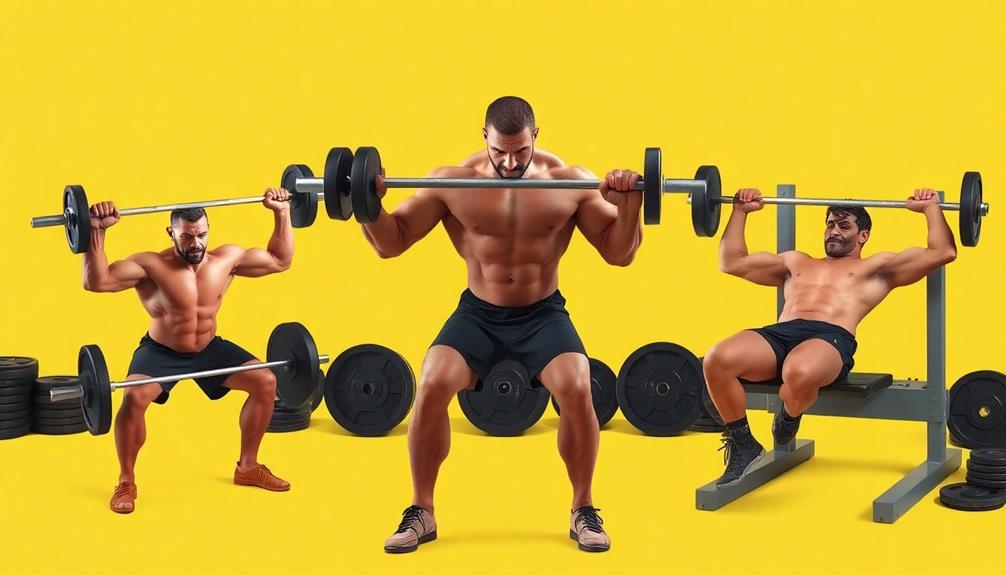To optimize your workout split for muscle gain and fat loss, balance push and pull exercises, incorporate full-body workouts, and target major muscle groups. Allow adequate recovery time between sessions, vary your rep ranges, and include compound movements that engage multiple muscle groups. Adjust your split to fit your schedule, ensuring consistency. Focus on exercises like squats, deadlifts, bench presses, and pull-ups to work large muscle groups efficiently. Don't forget to fuel your body with proper nutrition, including a post-workout protein shake for recovery. By following these tips, you'll create a well-rounded routine that maximizes your results. Discover how to fine-tune your approach for even better outcomes.
Core Insight
- Balance push and pull exercises to create a symmetrical physique and lower injury risk.
- Incorporate full-body workouts 2-3 times weekly to burn more calories and improve muscle coordination.
- Focus on exercises targeting major muscle groups like chest, back, legs, and shoulders for optimal gains.
- Allow 48-72 hours of recovery time between workouts for the same body part to prevent fatigue and injury.
- Vary your rep ranges to target different muscle fibers and prevent plateaus in your progress.
Balance Push and Pull Exercises

Balancing push and pull exercises is key for building muscle and losing fat. This method ensures you work all muscle groups equally, creating a symmetrical physique and lowering injury risk. Resistance bands can make push and pull exercises more interesting, especially for home or travel workouts.
Push exercises work the chest, shoulders, and triceps. Examples include bench presses and overhead presses. Pull exercises target the back, biceps, and rear shoulders, such as rows and pull-ups. Doing both types helps you get stronger and develop a well-proportioned body.
For the best outcome, do the same amount of push and pull exercises. You can alternate push and pull days or mix them in full-body workouts. Adjust the amount and difficulty based on your fitness level and goals. By keeping this balance, you'll build muscle, lose fat, and avoid overworking certain muscles.
Incorporate Full-Body Workouts

Full-body workouts are a great way to build muscle and lose fat. They work several muscle groups at once, which means you burn more calories and work more muscles. This leads to a faster metabolism, better muscle coordination, and improved functional strength. Foam rolling before and after your workouts can boost flexibility, lessen muscle soreness, and help you perform better.
To get the most out of full-body workouts, do 2-3 sessions a week. Make sure to rest enough between workouts. Focus on exercises that use many muscles at once, like squats, deadlifts, bench presses, and pull-ups. Do a mix of upper body, lower body, and core exercises each session.
Begin with 3-4 sets of 8-12 reps for each exercise. Adjust the weight and number of sets as you get stronger. Always warm up first and use proper form to get the best results and avoid getting hurt.
Target Major Muscle Groups

Targeting the main muscle groups is key for a good workout plan. Focus on exercises that work large muscles like your chest, back, legs, and shoulders. These moves use many joints and muscles at once, helping you gain more strength and muscle. To help your muscles grow and recover, think about adding a protein shake after your workout. When making your workout plan, try to include exercises that work these main muscle groups:
- Chest: bench press, push-ups, and dumbbell flyes
- Back: pull-ups, rows, and deadlifts
- Legs: squats, lunges, and leg press
Allow Adequate Recovery Time

After tough workouts, your muscles need time to recover and grow. Aim for 48 to 72 hours of rest before working the same muscles again. During this recovery, your body repairs muscle fibers to make them stronger. Rest days between workouts for the same body part are key. For instance, if you work your chest on Monday, wait until at least Thursday before targeting it again. In the meantime, train other muscles or take a break. Overworking your body can make you tired, hurt your progress, and cause injuries.
Pay attention to how you feel. If you need more rest, that's okay. Letting your body recover properly is just as crucial as lifting for building muscle and burning fat.
Vary Your Rep Ranges

Changing up your rep ranges is key for building muscle and burning fat. By using different rep schemes, you'll work your muscles in new ways and avoid hitting a wall. This method targets various muscle fibers and energy systems, giving you better overall results. Using this approach with muscle building supplements that have ingredients like Peak ATP or HMB can boost your progress and recovery even more.
To change your rep ranges effectively, try these tips:
- Low reps (1-5): Use heavy weights for strength and power
- Moderate reps (6-12): Focus on muscle growth
- High reps (15+): Work on endurance and burn more calories
Don't just stick to one rep range. Mix it up by switching between different rep schemes for each exercise or on different days. This variety will keep your body adapting and help you make steady progress in both muscle gain and fat loss.
Include Compound Movements

Compound movements are the best exercises for effective workouts. They work many muscles at the same time, making the most of your gym time and building overall strength. Compared to single-muscle exercises, compound movements help you burn more calories and grow muscle faster.
The table shows important compound exercises for upper body, lower body, and full body:
| Upper Body | Lower Body | Full Body |
|---|---|---|
| Bench Press | Squats | Deadlifts |
| Pull-ups | Lunges | Clean and Press |
| Overhead Press | Leg Press | Burpees |
| Dips | Step-ups | Thrusters |
| Push-ups | Glute Bridges | Turkish Get-ups |
Make sure to use at least one compound exercise for each main muscle group when you work out. This will build a strong base, improve functional fitness, and give better results for gaining muscle and losing fat.
Adjust Split for Your Schedule

Matching your workout split to your schedule is key for success. Consider your daily routine, work, and personal life when creating your plan. This helps you stay consistent and get the best results.
Keep these tips in mind when adjusting your split:
- Schedule tough workouts for when you have the most energy
- Plan rest days for when you're busiest with work or family
- Be open to changing your split if needed
Frequently Asked Questions
How Long Should Each Workout Session Last for Optimal Muscle Gain?
For best muscle gain, you'll want to aim for 45-60 minutes per workout session. Don't exceed 90 minutes, as this can lead to overtraining. Focus on intensity and quality rather than duration to maximize your results.
Is It Necessary to Take Supplements When Following a Workout Split?
While supplements aren't necessary, they can support your workout split. You don't need them to see results, but they may enhance your progress. Focus on a balanced diet first, and consider supplements as optional additions to your routine.
Can Beginners Effectively Use Advanced Workout Splits?
You shouldn't jump into advanced workout splits as a beginner. It's best to start with full-body workouts or simple splits. You'll build a solid foundation, learn proper form, and avoid overtraining. Progress gradually as you gain experience.
How Often Should I Change My Workout Split Routine?
You don't need to change your workout split often. Stick with a routine for 8-12 weeks to see results. If you're making progress, keep at it. Only switch when you plateau or get bored.
What's the Ideal Ratio of Cardio to Strength Training in a Split?
You'll want to aim for a 2:3 ratio of cardio to strength training in your split. That's about 40% cardio and 60% strength. However, you can adjust this based on your specific goals and fitness level.

